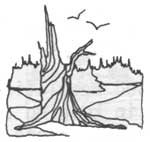|
The Clearwater Story: A History of the Clearwater National Forest |

|

Chapter 21
Selway-Bitterroot Wilderness
For many years the National Forests of Region One (N. Idaho and Montana) were plagued by large forest fires. The main reason for this was lack of rapid transportation. If a fire escaped the initial attack by the forest's firemen and crews and it was necessary to bring in men, food and equipment from outside sources, it took too long to get there to be effective. To solve this problem a system of trails was first developed. This did speed action some, but still traffic moved at a walking pace. So a system of roads and airplane landing fields were started in 1929. During the next five years many areas were opened up by roads. These roads included the Lolo Motorway, North Fork Road, Elk Summit, Tom Beall and many others.
Soon it appeared that unless some action was taken to stop the road building there would be no undeveloped areas left. The Forest Service decided to set aside by administrative action some of the undeveloped areas. These were called Primitive Areas in which no roads would be permitted. There were some airplane landing fields in these areas but no more were to be built. Thus the Selway-Bitterroot Primitive Area came into being in 1936. The Forest Service explained its action to the general public and a few people were interested and approved of the idea. There were no objections. The attitude of the great majority was complete indifference.
As time passed people began taking more and more interest in the Primitive Areas. They were not satisfied with having these areas set up by administrative order. They were fearful that what had been done administratively could be easily undone by the same process; so a demand arose to have the Primitive Areas made permanent Wilderness Areas by Act of Congress.
In 1953 the Forest Service started a study of the Selway-Bitterroot Primitive Areas to determine what its boundaries should be. In 1954 the Wilderness Society joined in the study. I went with this party on part of its journey. I had hoped that its members would consider the quality of areas to be included in the Wilderness Area. That is, were there scenic, historic, geological, high hunting and fishing values, etc., but all they seemed concerned with was getting the maximum area possible.
In 1961 public hearings were held on the Selway-Bitterroot Wilderness Area boundaries as proposed by the Forest Service. Some of these meetings were formal, but almost every community had some group that sponsored a meeting. I attended all the meetings in Idaho adjacent to the Clearwater National Forest and explained what was proposed and why. Usually Royce Cox of the Potlatch Forest Industries (now Potlatch Corporation) also attended and presented the lumberman's proposal which was for a much smaller area.
All sorts of questions and arguments were raised. Potlatch was accused of being selfish, but I noticed that most people interested in the wilderness had an axe to grind. The commercial packer was interested in what he could do to get more hunting, fishing, and camping parties. He opposed regulations on the kinds of camps he could build. Hunters were interested in keeping as many people as possible away from their usual camping areas. Few, indeed, were the people who gave any thought to the scenic, inspirational, or the natural attractions to be preserved.
Of course, everyone is entitled to their own ideas of wilderness. I have tried to express mine in the following poem.
WILDERNESS
To define a wilderness is difficult to do
For it means something to me and something else to you.
It is beauty, it is solitude, it is everlasting peace,
It is nature at its finest where man made changes cease.
But putting it in one sentence the very best I can
It's a maximum of nature and a minimum of man.
I stand on a high mountain and look out across the hills,
I am awed by their vastness and my heart within me thrills.
In the distance is a river and a multitude of creeks,
Row on row of ridges and lofty mountain peaks,
But there is not a house or road in the area I scan.
It's a maximum of nature and a minimum of man.
I sit by my campfire when the sun is sinking low
And I hear an elk bugle in a basin far below.
There is a bluejay scolding and a raven's raucous call.
Then a peaceful silence settles over all.
Just the wind a soughing as it has since time began.
It's a maximum of nature and a minimum of man.
I come to a fall in a rushing mountain stream
Where the mist is flying and the Crystal waters gleam.
In a pool trout are swimming and close by an ousel sings,
Above the roar of the fall his multinoted ballad rings.
The water foams and eddies just as it always ran.
It's maximum of nature and a minimum of man.
I walk within a forest where few other men have trod,
I feel I am a part of nature and much closer to my God.
I bow my head and humbly express my gratitude
For the wonders of nature and the peace of solitude.
That I am privileged to be a small part of God's plan
In a maximum of nature and a minimum of man.
| <<< Previous | <<< Contents>>> | Next >>> |
|
clearwater/story/chap21.htm Last Updated: 29-Feb-2012 |